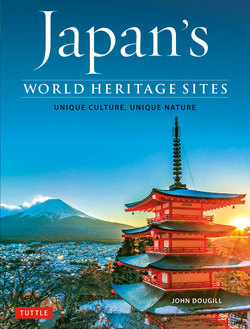Читать книгу Japan's World Heritage Sites - John Dougill - Страница 8
На сайте Литреса книга снята с продажи.
ОглавлениеITSUKUSHIMA SHRINE
THE QUINTESSENTIAL SYMBOL OF JAPAN
ITSUKUSHIMA SHRINE AT A GLANCE
REGISTRATION 1996, for combining architecture with nature in ‘a work of art of incomparable beauty’.
FEATURES A Shinto shrine in an inlet on the island of Miyajima, with 56 wooden structures supported by pillars and connected by corridors.
ACCESS From JR Hiroshima, 25 mins by train to JR Miyajimaguchi, then connecting ferry (10 mins) and 15 mins walk. A direct boat also leaves from Peace Park (55 mins).
PRACTICALITIES 6.30–17.30 (in season). ¥300. Miyajima Tourist Association tel. (0829) 44 0066 (free guided tours, or email taif@fureai-ch.ne.jp 10 days in advance). For accommodation information, see the wikivoyage page on Miyajima.
DATELINE
Ancient times—Miyajima regarded as sacred
593—Shinto shrine erected
1168—Present layout established
1868—Shrine and temple buildings separated
Perhaps no other landmark represents Japan as eloquently as Itsukushima. The torii (Shinto gate) that stands in the sea has become an iconic image, evoking the harmony with nature that typifies traditional architecture. The shrine seems at high tide to be floating on the sea, and its vermilion structures are offset by the blue waters and mountain greenery that frame them. Form, color and composition here come together in a glowing example of sensitivity to place.
The shrine was laid out in its present form by a warlord named Taira no Kiyomori (1118–81), who ascribed his victories to the benevolence of the Itsukushima kami (divine spirit) The positioning in an inlet was unprecedented, and to explain it several theories have been put forward. One has to do with ensuring worshippers did not defile the sacred island by stepping ashore. Another involves recreation of the Dragon King’s Palace of mythology. A third concerns representation of the Buddhist Pure Land (paradise), in fashion in Kiyomori’s time, according to which those who died were conveyed across a stretch of water to a divine abode.
Viewed from the beach at low tide, the shrine offers a scene of pleasing elegance. Prominent on the hill behind is a five-storey Buddhist pagoda and the huge 1,000-mat Hall.
The style of architecture derived from the aristocratic villas of Kyoto. Known as shinden-zukuri, it involved a network of elegant and spacious rooms connected by wooden corridors. Integration into the surrounds was created through the use of natural materials, such as wood and cypress roof tiles. The villa rooms featured views onto specially designed pond gardens, which are here replaced by the sea and the shoreline opposite.
Itsukushima’s ‘floating torii’ was first erected in 1168 to welcome pilgrims arriving by boat. Last renewed in 1875, it is made from decay-resistant camphor wood.
The most famous of the structures, the Great Torii, stands 52 feet (16 meters) high and weighs about 60 tons. Its purpose was to welcome worship-pers who would have originally arrived at the shrine by boat. (The buildings are similarly aligned, with the altar facing towards holy Mt Misen on the island behind.) The torii was last rebuilt in 1875, and the giant pillars are made from camphor trees 500–600 years old. Such is the tidal difference that at low tide it is possible to walk out to inspect them, while at high tide one can sail through.
Within the shrine complex is an assortment of subshrines as well as three different stages. One is a long stage for ceremonies, one a high stage for stately court dances and one a Noh stage—the only one in the world to be set upon the sea. It had to be specially adapted, as indeed did the corridors through the addition of gaps between floorboards to allow for the rising tide.
Included in the World Heritage listing are peripheral buildings, such as two striking pagodas. Interestingly, these are Buddhist, for like other religious complexes Itsukushima followed a fusion of Shinto-Buddhism until the Meiji Restoration of 1868, when the government forcibly separated the two religions. Several buildings were destroyed in the process, but the pagodas survived as did another World Heritage property, the Senjokaku (the 1,000-mat Hall). Though it was built for the chanting of Buddhist sutras, it serves now as a shrine to the soul of its founder, Toyotomi Hideyoshi (1536–98).
For those with time to spare, staying overnight is recommended for it allows visitors to savor the atmosphere once the crowds have gone. It also enables visitors to see the shrine in two different guises, at low and high tide. There are plenty of attractions, as typically for a Japanese pilgrimage site there’s a vibrant area of shops offering souvenirs and refreshments. There’s also a ropeway up Mt Misen; a night cruise to the torii; and hundreds of deer that pose for photographs (the animals are regarded as messengers of the kami). For those visiting in late July, there’s a floating festival when decorated shrine boats are joined by hundreds of lantern-lit fishing vessels—quintessential Japan, indeed.
At low tide it’s possible to walk out to the torii, where people place coins in the cracks of the pillars for good luck or gather shellfish to eat at home.
The architectural style, with its roofed corridors, was inspired by the aristocratic palaces of the Heian Period, which overlooked pond gardens.
Since medieval times, nearby streets have catered to throngs of pilgrim-tourists for whom hunting for souvenirs is part of the experience.
The connecting corridors that run between the shrine’s structures have gaps between the floorboards to relieve pressure from the rising water during high tide.
Despite the advent of modern tourism, the island is still considered sacred and to avoid ‘pollution’ births, deaths and burials take place on the mainland.
